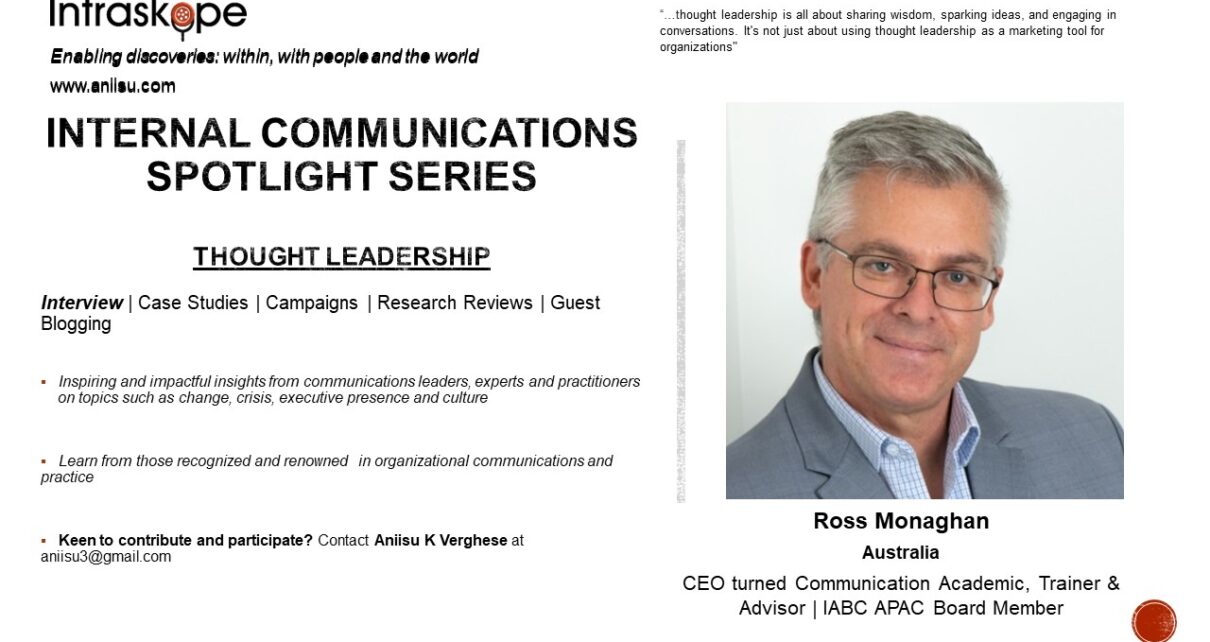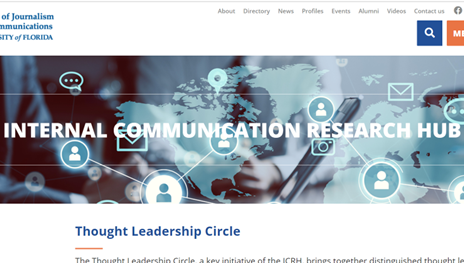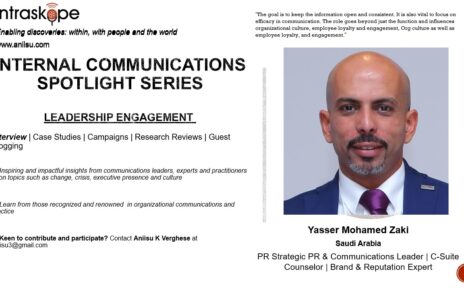How relevant is thought leadership for internal communications? How can leaders get adept at thought leadership? How can internal communicators influence the way leaders think about thought leadership?
Learn about this topic with edition #34 of Intraskope’s Spotlight Series.
I had the pleasure of interviewing Ross Monaghan, an academic at Deakin University in Melbourne, Australia, to delve into the topic of thought leadership. Ross has extensive experience as a thought leadership advisor and lecturer, making him the perfect guest for my vodcast.
“Thought leaders should be effective communicators, not just in broadcasting their messages, but also in engaging in meaningful conversations. Actively listening and valuing different opinions are essential components of thought leadership”, says Ross.
In the Spotlight on Internal Communications Series, I talk to thought leaders on topics interrelated with internal communications such as culture, crisis, change, executive presence and leadership. The goal is to help unravel why they matter, what can leaders and communicators learn from experts and how we can put insights to practice.
Watch this interview with Ross to learn more or read the transcript of our conversation below.
- How do you define thought leadership?
Ross Monaghan: Well, from my perspective, thought leadership is all about sharing wisdom, sparking ideas, and engaging in conversations. It’s not just about using thought leadership as a marketing tool for organizations. As someone with a background in various industries, I believe thought leadership involves driving discussions and bringing about positive change within both the organization and the industry as a whole. It’s about listening to others and encouraging them to share their thoughts and ideas.
2. How important is it for organizations, especially when it comes to internal communications?
Ross Monaghan: Internal communications play a crucial role in organizations, and thought leadership can greatly contribute to fostering a positive culture within the company. It’s essential to create an environment where employees feel comfortable expressing their ideas and collaborating with others. Internal communicators should provide spaces for people at all levels of the organization to share their thoughts and contribute to the company’s growth. Encouraging open communication and inclusivity is key to leveraging thought leadership within an organization.
3. What are the elements of thought leadership?
Ross Monaghan: In my view, thought leadership involves several elements. Firstly, having diverse experiences and understanding different perspectives is crucial. Being an industry expert is important, but it’s equally important to have a broader understanding of various functions within an organization. Building networks and connections with others in the industry is also vital. Thought leaders should be effective communicators, not just in broadcasting their messages, but also in engaging in meaningful conversations. Actively listening and valuing different opinions are essential components of thought leadership.
4. As a thought leadership advisor and lecturer, what advice do you give to executives?
Ross Monaghan: One of the key pieces of advice I give to executives is to embrace continuous learning. Expressing ideas and suggesting different approaches is important, but so is leveraging their wisdom and experience. Executives should actively seek insights from others and understand that there isn’t always one right solution to every problem. Being open to different perspectives and not being afraid to express their opinions is crucial. Additionally, showing humility and being willing to learn from mistakes is an important aspects of effective thought leadership.
5. How can leaders build thought leadership?
Ross Monaghan: Building thought leadership requires actively engaging with others and sharing ideas. Leaders should leverage various platforms such as blogging and videos to disseminate their thoughts and expertise. However, it’s equally important to use these platforms as opportunities for feedback and discussion. Engaging in conversations with industry experts and peers through mediums like YouTube, blogs, and podcasts can be highly beneficial. Additionally, connecting with individuals on a personal level, having one-on-one conversations, and organizing events or training sessions within the organization can foster thought leadership and spark innovative ideas.
6. What are the barriers that come in the way of establishing thought leadership?
Ross Monaghan: There are a few barriers that can hinder the establishment of thought leadership. One common obstacle is the fear of being wrong or lacking confidence in sharing ideas. Overcoming impostor syndrome and being willing to put ideas out there, even if they may evolve or change over time, is essential. In some cases, a cultural phenomenon known as the “tall poppy syndrome” can discourage individuals from standing out and expressing their opinions. However, aspiring thought leaders should overcome these barriers and focus on sharing their insights and ideas.
7. What can internal communicators do to get executives to pay attention to thought leadership?
Ross Monaghan: Internal communicators play a vital role in creating a culture of thought leadership within organizations. They can use various traditional and digital communication channels such as blogs and videos to capture executives’ attention. However, it’s crucial to use these platforms to initiate conversations and gather feedback from executives. Personal interactions, such as one-on-one discussions or organizing events, are also powerful tools for internal communicators to engage with executives and create opportunities for dialogue. Building connections, actively listening, and fostering meaningful conversations are key to gaining executive attention for thought leadership initiatives.
8. What advice do you have for students and young professionals who aspire to be thought leaders?
Ross Monaghan: My advice to students and young professionals aspiring to be thought leaders is to share their ideas without fear. Starting conversations and seeking feedback from others is crucial. They should actively engage with industry experts and thought leaders, leveraging various communication channels such as videos, blogs, and podcasts. This not only helps in spreading their own messages but also allows them to learn from the insights of others. Additionally, face-to-face conversations and networking events can be powerful ways to spark meaningful discussions and build relationships with other thought leaders in their field.
Ross Monaghan provides valuable insights into thought leadership, emphasizing the significance of open communication, continuous learning, and fostering conversations within organizations and industries. His advice serves as a guide for executives, internal communicators, and aspiring thought leaders alike.
Watch the video interview now!
Liked the interview? Post your comments and share it with your network.
Keen to contribute and participate in the Spotlight series? Write to me at [email protected]
Missed the earlier episodes? Watch them here: D. Mark Schumann (Culture), Peter Yorke (Executive Presence), Sia Papageorgiou (Leadership Communications), Dianne Chase (Strategic Storytelling), Gloria Walker (Communication Planning), Rebecca Sangster-Kelly (Stakeholder Management), Ray Walsh (Localizing Employee Communications), Prof. Matt Tidwell (Reputation), Geri Rhoades (Manager Communications), Erik K Meyers (Business Acumen), Russell-Olivia Brooklands (IC Practice Governance), Paul Barton (Public Speaking and Business Communication), Cyrus Mavalwala (Digital Communication), Elvera N Makki (Social Impact Communication), Philippe Borremans (Communication Preparedness), Magdalena Petryniak (Influence in Communications), Priya Bates (Communicating Diversity & Inclusion), Zora Artis (Communication Alignment), Diana Bonczar (Communication Execution), Jane McConnell (Gig Mindset), Paul Mathews (Trust & Communications), Brad Whitworth (Creativity in Communication), Zane Ewton (Podcasting), Andrea Greenhous (Employee Experience), Jonas Bladt Hansen(Digital Technologies), Luis Suarez (Data Analytics & KM) , Laura McHale (Neuroscience in Communications),, Christopher Flores (Internal Communication Hiring) Chaya Mistry ( Human Leadership), Jenni Field (Organizational Productivity), Mike Klein (Communication Innovation), Gihan Hyde (ESG Communications) and Yasser Zaki (Leadership Engagement).
Keen to participate in the ongoing series on Personal Branding, Crisis Communications, Internal Communications or CSR Communications? Drop me a note at [email protected]
Here are Internal Communications resources you can use:
- Learn: Internal Communications Fundamentals Course on Thinkific
- Read my latest book: Inclusive Internal Communications (2023)
- Internal Communications Series: https://forms.gle/KcqmPzLwq7NQi5Km6
- Chat with Aniisu – Internal Communications: https://www.instamojo.com/intraskope/connect-with-aniisu-60-minute-personalized-d/?ref=store
- Internal Communications workshops: https://bit.ly/2zdBRl1
You can also visit my website www.intraskope.com and You Tube channel to know more about my work.
#IC #communication #leadership #leadershipengagement #engagement #internalcomms #communications #internalcommunications #covid19 #RossMonaghan #thoughtleadership



